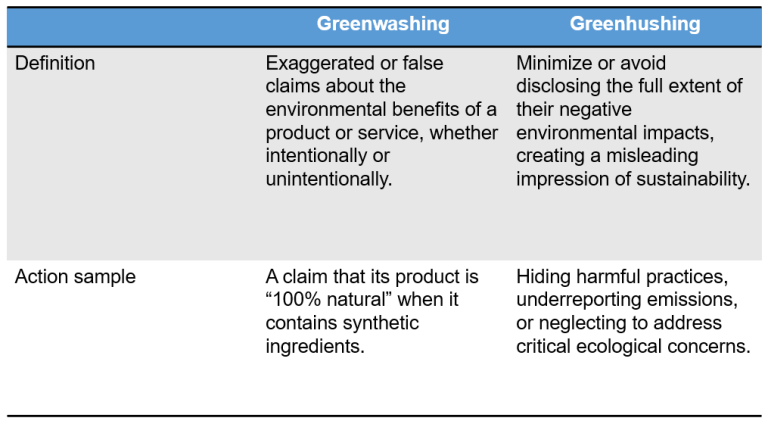In recent years, the concept of sustainability has gained significant attention worldwide. Individuals, corporations, and governments have all taken strides toward implementing sustainable practices to combat climate change and protect the environment. However, a new phenomenon has emerged that threatens the progress of sustainability efforts – greenhushing.
Greenhushing is essentially an act of deception, where organizations present themselves as environmentally conscious while simultaneously engaging in environmentally harmful practices. The goal of greenhushing is to create a positive image and gain the trust of consumers and stakeholders without making substantial efforts towards sustainability. This practice allows companies to capitalize on the growing demand for eco-friendly products and services, potentially leading to increased profits. Greenwashing, a similar but more well-known practice, involves making misleading or exaggerated claims about a company’s sustainability efforts, whereas greenhushing is more focused on hiding unsustainable practices.
Figure 1
Greenwashing vs. Greenhushing

According to the European Commission, over half of online green claims lack supporting documentation and 42% of corporate environmental claims are considered to be inaccurate or fraudulent. The main motivation for a corporation to greenwash or even greenhush is the worry that it would scare away asset owners by being accused of not doing enough to protect the environment.
As surveyed by the South Pole in 2022, 25% of the 1,200 corporations polled said they would not make their science-based net zero emissions targets public. It indicates that businesses may set these goals but decide against disclosing them to the public.
Businesses are apprehensive about failure due to the rapidly changing economic environment. They also fear scrutiny from people who may assess their efforts and demand improvements. Moreover, some countries like France have specific regulations on corporate environmental claims, and similar rules may emerge in other countries.
The Impact on Sustainable Implementation
The greenhushing phenomenon poses significant challenges to the overall goal of sustainable implementation for the private sector. First and foremost, it undermines the trust of consumers and stakeholders who rely on accurate information to make sustainable choices. When companies engage in greenhushing, they divert attention and resources away from sustainable initiatives. This can result in priorities distortion, with investments being directed toward marketing strategies rather than meaningful environmental actions.
Moreover, greenhushing can create a false sense of accomplishment, leading to complacency and a lack of motivation to pursue genuine sustainability measures. Organizations may be less likely to make the necessary adjustments needed to meet long-term sustainability goals if they think they can fulfill stakeholders’ and consumers’ expectations by merely projecting a green image. This not only hinders sustainability progress but also burdens the collective effort to address urgent environmental issues and leads to a missed chance to evolve toward a greener future.
Companies engaged in greenhushing practices expose themselves to reputational risk. A company’s genuine potential and intentions could be misrepresented to the market in ways that could harm shareholders. By neglecting sustainability, companies risk missing out on inspiring positive change within their industry, attracting stakeholders who seek to invest in sustainable businesses.
Combating Greenhushing in the Private Sector
To tackle the issue of greenhushing, consumers, stakeholders, and regulatory bodies must remain vigilant and hold organizations accountable for their claims. One way to achieve this is through increased transparency and standardization of sustainability reporting. Clear guidelines and regulations can ensure that companies provide accurate and verified information regarding their sustainability efforts, making it easier for consumers to make informed choices.
To ensure effective sustainability practices, companies should:
- Embrace Transparency: Companies must prioritize transparency and disclose accurate information about their environmental practices. Openly sharing sustainability initiatives and challenges builds trust with stakeholders.
- Establish Strong ESG Governance: Implement a robust ESG governance program with buy-in from management and the board. Integrate ESG considerations into risk management procedures for a comprehensive approach.
- Educate Board and Management: Conduct educational programs on sustainable fundamentals and related risks. A deep understanding of sustainability goal-setting and reporting starts with proper education.
- Stay Compliant with Regulations: Keep up-to-date with evolving regulations and ensure compliance. Adhering to rules prevents improper reporting, though it may require significant resources.
- Scenario Planning for Risks: Anticipate and address greenwashing risks through scenario planning. Changing perceptions and lever reliance demand proactive preparation for potential accusations.














